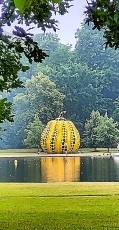Adam Yamey's Blog: YAMEY, page 43
August 9, 2024
Derek Jarman’s cottage near the nuclear power stations at Dungeness
A PRIVATELY OWNED road, Dungeness Road, heads from Battery Road, which is south of Lydd on Sea, to the Dungeness nuclear power stations. One of these two enormous units began producing electricity in 1965, and the other between 1983 and 1985. By 2018, both had been closed, and are not likely to be used again. Along the road leading to the power stations, there are houses, each one well-spaced from its neighbours. The terrain along which the road runs is flat, sandy, gravelly, windswept, and treeless. Scrubby little plants grow here and there, and the seacoast is nearby. The disused power stations dominate the southern horizon.
In 1987, the film director Derek Jarman (1942-1994) purchased Prospect Cottage, a wood cladding Victorian fisherman’s hut. It stands on Dungeness Road 1489 yards northeast of the power stations. From its garden, the power stations look like a huge liner on the horizon. Jarman, who was keen on garden design, created an unusual garden using bits of debris of all sorts as sculptural features. These objects are surrounded by gravel in which plants hardy enough to survive in the exposed terrain were planted. The garden he created is unusual but intriguing. It has a strange extraterrestrial feel about it, but is visually satisfying.
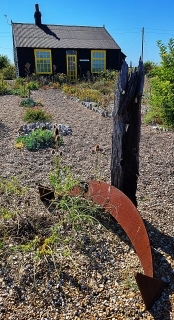
Jarman lived in the small cottage until his death. The walls of the cottage are painted with black tar and the window frames are yellow. One wall of the building has words from a poem by John Donne written on it in large wooden letters. After his death, Jarman’s friend Keith Collins inherited it and lived there until his death. It was put up for sale in 2018. In 2020, enough money had been raised to save it for the nation. Currently, it is being looked after by an organisation called Creative Folkestone.
When we visited Prospect Cottage and its garden on a sunny afternoon in August (2024) there were a few other visitors admiring the garden. Entry to the cottage is generally not permitted. We were told that occasionally it can be used by artists as part of residencies arranged by Creative Folkestone. As for the garden, it seemed that no one objected to visitors looking around. We did ask permission from someone using the cottage, and she told us to go ahead. Although the road leads to Dungeness lighthouse, which is open to the public and attracts many visitors, few of those on their way to it stop at Prospect Cottage. Having seen this curious place, I can recommend it as a destination if you happen to be in east Kent.
Charles Dickens used to write by the sea at Broadstairs
THE VICTORIAN AUTHOR Charles Dickens (1812-1870) visited Broadstairs, a seaside town in east Kent frequently. During a recent visit to the town in August 2024, we saw three buildings which are associated with the famous author.
The Royal Albion Hotel hosted Dickens several times. Nearby, there is what is now the Dickens House Museum. This was the home of Miss Mary Pearson Strong, who was the inspiration for Betsey Trotwood in “David Copperfield”.
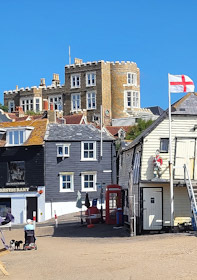
On a hill overlooking both the popular Viking Bay Beach and other parts of Broadstairs, there is a large building with castellations. This was built in 1801 as Fort Howe. It was, and still is, a private residence. It was here (and at the Albion Hotel) that Dickens used to write while staying in Broadstairs. The author leased the house from the 1840s until 1852. Some people claim that the house was the inspiration of the title of Dickens’ novel “Bleak House”, but this is by no means certain.
At thus point, I must admit that I have not read any Dickens apart from highly abridged versions of “A Christmas Carol” and “Oliver Twist”. Having now visited Broadstairs, I feel there is a good chance that I might tackle a full novel, maybe “Bleak House” or “David Copperfield”. Which would you recommend?
August 8, 2024
Skin pigmentation and figurines at Knole House in Kent
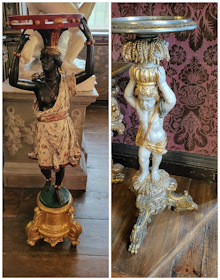
At some National Trust properties, figurines with dark skin pigmentation, such as the one on the left (first picture), are labelled with an apologetic warning that the figurine depicts a person of colour in a demeaning pose. Not so in Knole House, near Sevenoaks in Kent. In the same room, also without a label, there is a figurine depicting a person with pale skin in the same demeaning pose.
August 7, 2024
An architect from Korea making something out of nothing in a London park
ALMOST ALWAYS I ENJOY the annual temporary pavilions erected beside the Serpentine South Gallery in Kensington Gardens. This year’s offering was designed by the South Korean architect Minsuk Cho (born 1966 in Seoul). The Serpentine website (www.serpentinegalleries.org/) explained:
“Tracing the history of past Serpentine Pavilions, Minsuk Cho observed that they often emerge as a singular structure situated at the centre of the Serpentine South lawn. To explore new possibilities and previously untold spatial narratives, Cho approaches the centre as an open space. The 23rd Serpentine Pavilion envisions a unique void surrounded by a constellation of smaller, adaptable structures strategically positioned at the periphery of the lawn.”

The five structures surrounding the void (or open space) in the middle of the pavilion compound vary in shape and purpose. One serves as a library, another as a café serving area with minimum seating, another as a children’s play area, another is a kind of hallway, and the fifth is supposed to represent a tea house.
Apart from two of the small buildings (the play area and the library), I did not find the others visually satisfying. Also, I did not feel that the five structures surrounding the central space were in harmony with each other. All in all, I was unimpressed by this year’s so-called pavilion.
I realise from reading the information on the Serpentine’s website that Minsuk Cho was trying to express a set of concepts by designing the small complex of buildings that together form the pavilion. However, without knowing that, the result looks unsubstantial compared with almost all the pavilions that have preceded it over the years. The architect’s ideas have not translated well into concrete forms. Apart from this, the current pavilion, unlike its predecessors, has few places for people to sit and enjoy the space. In all the pavilions that have been constructed before this year, there has been ample place to sit and rest. And providing such a place within uniquely designed architectural spaces has, until this year, been one of the things that makes the pavilions accessible for people of all ages to enjoy – whether or not they have an interest in the architecture or its designer.
August 6, 2024
A giant gourd in Kensington Gardens
August 5, 2024
Lost and found at the Founders near Barbican
THE LIVERY COMPANIES were founded long ago by members of the same craft or trade. They were established originally to protect their businesses from rogue traders and to ensure that anyone practising a trade worked to satisfactory standards and good quality. Today, the livery companies still exist although now they are mostly involved in the life of the City of London and philanthropic activities.
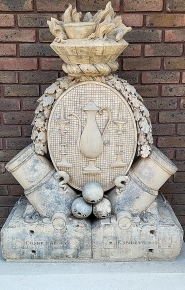
The Founders Company, which was established in 1365, was made up of members who cast metal as their trade. They worked with castable metals such as brass and latten (a combination of copper and zinc). Their current headquarters are housed in a modern building just east of the east end of the church of St Bartholomew the Great (near the Barbican). One side of the building runs along the narrow St Bartholomews Passage. It was there that, at ground level, I spotted a bas-relief portrayal of a coat of arms made in white material.
A small information panel next to the crest related that this white material is Coade stone. This material, which was invented in the late 18th century, was an artificial material containing various ingredients. It solidified by firing in a furnace. This durable, weather-resistant material is easy to mould before firing, and was therefore favoured by sculptors and building designers. It went out of fashion by the 1840s.
The Coade stone crest outside Founders Hall was made in 1800, and then it got lost during the 19th century. Many years later, in the early 21st century, it was found and presented as a gift to its original owners, the Founders. It commemorates the Company’s three Masters, who served in 2013, 2014. And 2015.
Although I have visited St Bartholomew the Great many times, it was only yesterday, the 31st of July 2024, that I first walked along Bartholomew Passage – just to see where it led. Luckily, on the way I found the well-preserved Founders’ Coade stone crest.
August 4, 2024
A back passage near to London’s Smithfield and Barbican
THE CITY OF LONDON has suffered many upheavals including, to mention but a few, the great Fire of London (1666), heavy bombing during WW2, and often overzealous redevelopments after 1945. Despite these major changes, remains of mediaeval London can still be found. One of these is close to the church of St Bartholomew the Great, which escaped being damaged during WW2, and has been standing since 1123. It was founded as part of an Augustinian priory that was dissolved by Henry VIII in 1543. Close to this fascinating church, and running in a straight line from east to west is the narrow East Passage.
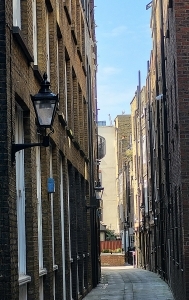
This alleyway is about 80 yards long and lined with the rear facades of buildings – mostly not particularly old. Yet, East Passage has been in existence since the dissolution of the priory in the 16th century (www.ianvisits.co.uk/articles/londons-alleys-east-passage-ec1-36703/). It is a thoroughfare developed on land that had belonged to the priory, and was sold to Sir Richard Rich (1496-1567), who was Lord Chancellor during the short reign of King Edward VI, successor to Henry VIII. East Passage was one of a new series of streets laid out soon after the priory was closed. As the author of the ianvisits.co.uk website pointed out, the group of small straight streets, of which East Passage is one, was one of the earliest planned developments in London (with straight rather than haphazardly arranged, curvy streets), predating the planned development of Covent Garden in the 17th century.
Today, East Passage is about half the length it used to be. Before it was known as East Passage, it was known as ‘Back Court’ or ‘Back Street’. At its west end, there is the rear of a pub called The Old Red Cow. It is one of the longest established pubs near to Smithfield meat market, although the building housing it looks as if it was built in the 19th century. Close to this hostelry, but not on East Passage, there is another pub, The Hand and Shears. Established in 1532, but housed in a more recent building, whose name reminds us that it used to be frequented by cloth merchants. A note in a website (https://darkestlondon.com/tag/old-red-cow/) mentioned that The Hand and Shears:
“… was used as the venue to settle disputes and grievances of people who visited the annual St Bartholomew’s Fair – licences were granted, weights and measures were tested, and fines imposed on fraudulent traders. For many years, the Fair was officially opened from the inn’s doorway by the Lord Mayor – but impatient clothiers would later wait at the pub the night before and declare it open on the stroke of midnight, signalling to gathering crowds that the Fair was officially open by waving a pair of shears in their hands.”
Possibly, I would not have noticed the slender East Passage had we not been sitting in a café nearby. I spotted it through the window of the Pret a Manger on Long Street that runs parallel to East Passage, and felt I had to explore it. As I walked along it, I had not idea that this small back passage had such a long history and would never have existed had Henry VIII not fallen out with the Pope in Rome.
August 3, 2024
From sewer to seating on the streets of London
THE VICTORIA EMBANKMENT was constructed along the River Thames in the 1860s. It was built to enclose a newly constructed sewer: the Main Low Level Sewer, which was part of the grand sewage system improvement project designed by Sir Joseph William Bazalgette (1819-1891). The wall of the embankment facing the river was constructed from large brick-shaped, carved granite stones, each weighing about 1 tonne. Several of these have had to be removed to construct a new sewage conduit – the Thames Tideway Tunnel.
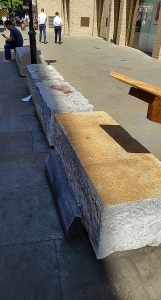
58 of the granite stones have been repurposed to become a series of open-air public art installations. This series was created by Matthew Barnett Howland, Oliver Wilton, and CSK Architects. Small groups of these have been placed in seven locations: St Peter’s Hill, Carter Lane Gardens, St Paul’s Cathedral, Christchurch Greyfriars Church Garden, King Edward St, Little Britain and Smithfield Rotunda. Today, the 31st of July 2024, we came across the group placed in Little Britain, which is not far from Barbican Underground Station. What we saw were 3 of the huge locks of granite arranged in a straight line. A gentleman was using one of them as a bench while he looked at his mobile telephone. Next to them, a wooden sign explained what is going on. This was useful because if there had been no sign next to them, we might not have given them a moment’s notice.
You might well be wondering why this series of stones were placed at seven places in London. I will leave it to someone else to explain:
“The idea behind the project is to stimulate discussion about reuse, material lifespan and cultural heritage, at a time when we can make a significant contribution to a more sustainable built environment.” (www.cityoflondon.gov.uk/services/streets/from-the-thames-to-eternity-installation)
I wonder what Bazalgette would have thought of this.
August 2, 2024
Blades and flames and other hazards in the kitchen
WHILE PREPARING A SAUCE for pasta today, my mind shot back to my mother in the kitchen during my childhood. Many people regarded her as being a competent cook. She was an enthusiastic follower of the recipes in cookbooks by Elizabeth David. She bought only the best cooking utensils, and sourced many ingredients in the Mediterranean food stores that used to exist in Soho – a few remain, but many have gone. As a child, I was allowed in the kitchen to watch when my mother was cooking. The more I saw, the greater my desire to try to cook. However, this wish was not to be fulfilled while my mother was alive.
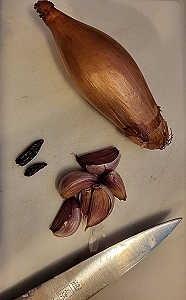
My birth and the first few months of my life were difficult as far as health was concerned. Consequently, my mother was highly protective of me, and then later also of my sibling. My mother saw danger everywhere, and not least in the kitchen. There were sharp knives, razor like tin can lids, and the risk of getting burnt either by the oven or the hot things prepared on it. We had electric hob rings because my mother was anxious about gas explosions and open flames. I was allowed to watch her cooking, but not to touch anything she was using. Curiously, even though knives were involved, I was often asked to wash the dishes, cutlery, and cooking utensils.
Sadly, my mother died at a young age. I was 28 when she went, and still residing in the family home along with my father, who had no interest in cooking. He enjoyed good food, but would have no part in preparing it. With my mother no longer around and a well-equipped kitchen, I began to experiment with cooking, and enjoyed the activity.
Over the years, I have done much cooking, and still enjoy doing it. I am not sure what made me think of my mother today as I prepared the pasta sauce, but it might have been the pan in which I was making it. For, that pan was one that my mother used often. She must have bought it back in the 1960s, and because she purchased only the best, it is still perfectly usable much more than 50 years later.
My wife is a good cook, but I do most of the day-to-day cooking. When she told a friend of ours that I do most of the cooking, the friend asked my wife:
“Don’t you feel diminished as a woman if Adam does most of the cooking?”
My wife, who is quite happy with the arrangement, replied with another question:
“Do I look like an idiot?”
Sometime later when our daughter was a toddler, she and my wife visited some friends. After a few minutes, our little one, used to seeing me cooking, came running out of the kitchen with wide open eyes, and said to my wife:
“Do you know, Mama, but the Mummy is doing the cooking in this house.”
My wife answered:
“Well, I never…”
August 1, 2024
Sunday morning stroll along the river from Hogarth’s grave to Hammersmith Bridge
EARLY ON SUNDAY mornings, we often drive to the riverside between Chiswick and Hammersmith. Usually, a parking place can be found on Chiswick’s picturesque Church Street close to the church of St Nicholas, in whose graveyard the artist William Hogarth is buried. This narrow lane leads from the Hogarth Roundabout to the riverside. Chiswick Mall follows the riverbank. On one side it is lined with elegant houses, some of which are several hundred years old. Between the Mall and the water’s edge, there is a chain of private gardens, across which you can catch glimpses of the river. All along this road, there are plenty of trees and flowers to be enjoyed.
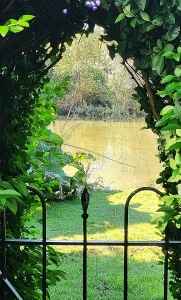
Heading downstream, Chiswick Mall ends, and leads into the short Hammersmith Terrace, which is lined with houses where some famous printers and typographers once lived. Beyond Hammersmith Terrace, from which the river is hidden by houses, we regain views of the water as we walk along Upper Mall. This riverside promenade heads east and ends at a narrow passageway next to the Dove Pub, but before reaching it, we pass Kelmscott House, once a home of the artist and social reformer William Morris.
After passing the Dove pub, we enter Lower Mall. This riverside thoroughfare runs past Furnivall Gardens and then beneath Hammersmith Bridge, eventually reaching the Riverside Studious, where in addition to seeing one of the Daleks used in the “Dr Who” TV films, you can obtain refreshments in a pleasant café with a good view of the bridge. Sadly, this Victorian strucruer is in such a poor state of repair that only pedestrians and cyclists can cross it.
By walking between Hogarth’s grave and the Riverside Studios, you will have walked almost exactly one mile. We do this pleasant stroll quite often, and are never disappointed. Along the way, there are potential hazards including self-important joggers, who cannot understand that they are not the only people allowed to use the pathways, and cyclists, who seem to have the same arrogant approach as the joggers. That said, walking between St Nicholas and Hammersmith Bridge is a worthwhile and enjoyable experience, and along the way you will pass many places of historic interest, which are described in detail in my book “Beyond Marylebone and Mayfair: Exploring West London”.

